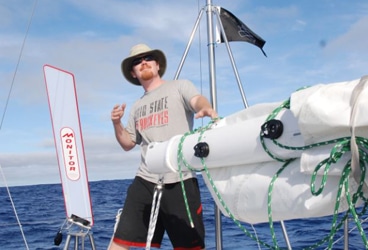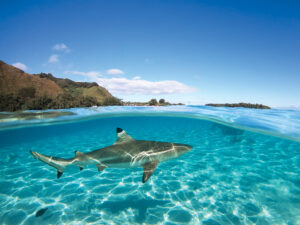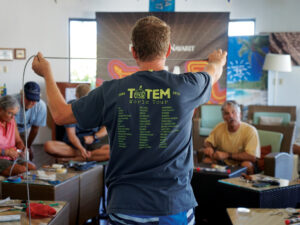
The trade winds can either be a blessing or a curse. I sailed roughly 10,000 miles of the Pacific Ocean north to south while sailing around the Americas. On my way to Cape Horn I had to sail directly into these same trade winds for 41 days straight. Which is the longest I’ve ever been on one tack. I don’t like beating into the wind and seas for 41 minutes, let alone 41 days. I remember thinking how nice it would be to turn west, put the trades on my quarter and sail across the Pacific (the proper way). A couple years later, that’s exactly what I’m doing.
The easterly trade winds do present a problem for our research. It’s hard to slow down the boat enough to drag our Avani net when you have 6 foot seas pushing you along. Forentino gave us one of their “shark” drogues before we left, which is supposed to be used in heavy weather. We deploy it every day while collecting our samples. Even with a drogue we don’t slow down enough, a few days ago I had to start tying an anchor to the back of the drogue, burying the drogue deeper in the water. It’s rather silly to be down to a third reef and dragging a drogue in 15 knots of wind but that’s the only way we can slow Sakura down to 3.5kts.
We have accomplished phase 1 of our marine plastics research. Before we left Nicole spoke with several scientists to determine where scientists have and haven’t done marine plastics research in the Pacific. During phase 1 we were trying to find the southeastern edge of the North Pacific Gyre (Pacific Garbage Patch). We thought we found it few days ago, we had to sample in a southerly direction for a few more days to verify the finding, and now it’s verified.
Phase 2 is a comparative study. We will sail south of the Hawaiian Islands sampling for micro plastics in the trades winds. Most of the research has been done in the known Gyre region, very little has been done in the easterly trades. Buy collecting samples in the trades, when back on land, we can compare our findings with the known finding in the Pacific Gyre to determine how much of the micro plastics are staying in the Gyre and how much is getting displaced by the trade winds.
In some ways this expedition reminds me of my circumnavigation of the Americas. We are on a small boat with a monitor windvane, sloop rig, single line reefing, freeze dried food and a manual water maker. I used these same systems for 309 days while going around the Americas, in many ways I copied St. Brendan to keep things nice and familiar. On the other hand, I’m sailing with a strong, smart, beautiful woman. On a brand new boat, with no black mold, ice bergs, fog and general chaos. Not to mention this is a research expedition.
Daily life is pretty simple, although it’s hard for me to say when the day begins as most nights I hardly sleep a wink. I’m too busy keeping a course and listening for problems. Once we do “get up” we make a cup of coffee, which is breakfast, write a report in the ships log book and prepare to drag our net and collect samples. It takes a half hour to set up the spinnaker pole and deploy the drogue. While we are collecting our sample we pump the water maker. Nikki and I take shifts pumping the water maker for an hour and a half to make the 5 litters of water we need for the next 24 hours. After collecting our samples we pull the drogue, stow away the spinnaker pole and make dinner. I’m not really sure if dinner is the right word for it, as we one eat once a day. The rest of the day we manage the vessel, read, write and try to rest. Then we do it all over again the next day, and the next day, and the next day. The simplicity of life at sea.
The film about my circumnavigation of the Americas will be done soon, you can see the trailer at www.RedDotontheOcean.com
We believe that while no one can do everything, everyone can do something. Our project is committed to serving the ocean research community. We provide data that explores man’s relationship with our planet’s oceans. Learn more about the Ocean Research Project at www.oceanresearchproject.org.








